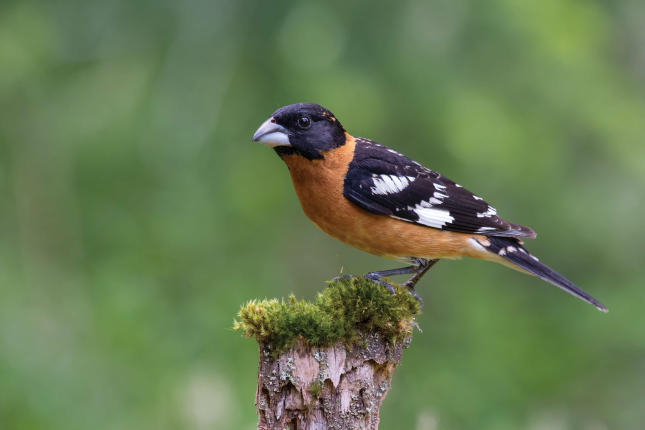Bird of the Month: Black-headed Grosbeak
Every July, the Colorado landscape is brought to life with the rich, melodious songs of the Black-headed Grosbeak (Pheucticus melanocephalus). These striking songbirds, easily recognized by their vibrant plumage and bold markings, are a favorite among birders and backyard nature lovers. A member of the Cardinalidae family, they are close relatives of cardinals and buntings and bring a burst of color to our warm summer days.

Sometimes described as the robin with opera training, the male grosbeak’s song is a complex, lilting series of phrases that seem to pour effortlessly from the treetops. But these birds are more than just a pretty sound. From their fascinating migratory journeys to their cooperative parenting styles, the Black-headed Grosbeak has earned its spot as our July Bird of the Month!
The Black-headed Grosbeak is a medium-sized songbird, measuring about 7.5 inches in length with a wingspan of 12.6 inches. Males have a striking black head, bright orange breast and sides, and black-and-white patterned wings. Females and juveniles have more subdued coloring, with brown and white streaked plumage and hints of warm yellow or orange on their underparts. Females also sport a fierce eyebrow mark. Both sexes share the thick, conical bill typical of grosbeaks, which is perfectly suited for cracking seeds and foraging for insects.
Habitat
Black-headed Grosbeaks are migratory birds that breed in western North America, including much of Colorado, and winter in Mexico and Central America. They prefer deciduous and mixed woodlands, riparian corridors, forest edges, and suburban areas with mature trees. In Colorado, look for them in cottonwood groves, foothill shrublands, and wooded areas near streams and rivers. They are frequently seen in parks, gardens, and neighborhoods with plenty of tall trees, especially if food is abundant.
Food Preferences
Black-headed Grosbeaks have a diverse diet that includes insects, seeds, fruits, and nectar. During the breeding season, they consume large numbers of insects and spiders, which provide the protein needed for raising young. They also eat beetles, caterpillars, and other small invertebrates.
They’re known to enjoy a variety of seeds, particularly sunflower seeds, and will often visit backyard feeders. Fruits like berries, cherries, and apples are also favorites. Occasionally, they may be seen sipping nectar from hummingbird feeders or visiting flowering shrubs.
Mating and Nesting
Black-headed Grosbeaks are monogamous during the breeding season, and courtship begins shortly after their arrival in spring. Males attract females through song and a display of their bright plumage, often performing a fluttering flight to show off their colors.
Once paired, the female builds the nest, typically placed on a horizontal branch in a deciduous tree or large shrub. The nest is a loose, open cup made of twigs, grasses, and plant stems. Both parents may help collect nesting materials, but the female constructs the majority of the structure.
The female lays 2–5 eggs, which she incubates for about 12–14 days. Both parents share in feeding the hatchlings. The young birds fledge roughly 10–12 days after hatching, though they remain near the nest and continue to be fed by their parents for several more days before becoming fully independent.
Black-headed Grosbeaks usually only raise one brood per season, though in ideal conditions a second brood may be attempted.
To attract Black-headed Grosbeaks to your yard:
Offer black oil sunflower seeds, safflower seeds, and peanuts in feeders.
Provide fruit such as orange halves or apple slices.
Plant native fruiting trees and shrubs like chokecherry, serviceberry, and elderberry.
Maintain a bird bath or shallow water source.
Keep your yard pesticide-free to ensure insects are available.
When out birding, listen for their rich, warbling song and watch the mid to upper canopy of trees for their bold colors and distinctive beak.
Conservation Concerns
Black-headed Grosbeak populations are currently stable, but habitat loss and pesticide use pose ongoing threats. Deforestation and urban sprawl in both breeding and wintering ranges can impact their access to food and nesting areas.
Insecticide use, particularly those affecting caterpillar populations, can reduce food availability during the critical nesting period. Supporting sustainable gardening and agriculture practices helps protect these birds’ habitats and food sources.

